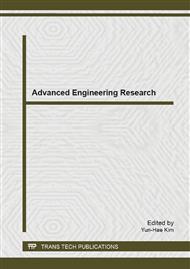[1]
Pfurtscheller G, et al: Brain-computer interface-a new communication device for handicapped persons, J Micro comput Appl, Vol. 16 (1993), pp.293-299.
DOI: 10.1006/jmca.1993.1030
Google Scholar
[2]
KohdaT: Pseudo Noise Sequences by Chaotic Maps and their Correlation Properties, IEICE Trans. Commun, Vol. 76(8) (1993), pp.855-862. E.
Google Scholar
[3]
Hlger Kantz, Thomas Schreiber: Nonlinear Time Series Analysis, edited by Cambridge University Press (2000).
Google Scholar
[4]
Sutter E E: The Brain Response Interface: Communication through Visually-induced Electrical Brain Response, J Microcomput Appl, Vol. 15 (1992), pp.31-45.
DOI: 10.1016/0745-7138(92)90045-7
Google Scholar
[5]
Farwell L A and Donchin E: Talking off the top of your head: toward a mental prosthesis utilizing event-related brain potentials, Electroenceph Clin Neurophysiol, Vol. 70 (1988), pp.510-523.
DOI: 10.1016/0013-4694(88)90149-6
Google Scholar
[6]
Vivas, E.L. -A.
Google Scholar
[1]
Garcia-Gonzalez, A.; Figueroa, I.; Fuentes, R.Q.: Discrete Wavelet transform and ANFIS classifier for Brain-Machine Interface based on EEG, 2013 6th International Conference on Human System Interactions (2013), pp.137-144.
DOI: 10.1109/hsi.2013.6577814
Google Scholar
[7]
Wijayasekara, D.
Google Scholar
[1]
Manic, M.: Human machine interaction via brain activity monitoring, 2013 6th International Conference on Human System Interactions (2013), pp.103-109.
DOI: 10.1109/hsi.2013.6577809
Google Scholar
[8]
H. Wang: Nonstationary random signal analysis and processing, edited by National Defense Industry Press, Beijing (1999).
Google Scholar
[9]
Guanglong Xie; Buhan Zhang; Jianghong Wang; Chengxiong Mao; Xu Zheng; Yanlin Cui; Yidan Gao: Research on the propagation characteristic of non-stationary wind power in microgrid network based on empirical mode decomposition, Power System Technology (POWERCON), 2010 International Conference on (2010).
DOI: 10.1109/powercon.2010.5666046
Google Scholar
[10]
Regan D.: Human brain electro-physiology. Evoked potentials and evoked magnetic fields in science and medicine. edited by Elsevier, Amsterdam (1989).
Google Scholar
[11]
Q. Gu: System and simulation, edited by Tsinghua University Press, Beijing (1995).
Google Scholar
[12]
Widrow B., Stearns A.D.: Adaptive Signal Processing, edited by Sichuan University Press, Chengdu, (1989).
Google Scholar
[13]
Lv Jin-hu, Lv Jun-an, Chen Shi-hua: Chaos Time Series Analysis and its Application, edited by Wuhan University Press, Wuhan (2002).
Google Scholar
[14]
Jeha Ryu, Kil To Chong, Ryojun Ikeura, Qingkai Han: Chaotic time series analysis of vision evoked EEG, ICMIT 2009: Mechatronics and Information Technology, Vol. 7500 (2009), pp.11-7.
DOI: 10.1117/12.858256
Google Scholar
[15]
Chi, Dezhong; Wang, Hongjie: Short-Term Load Prediction Based on Chaos Time Series Theory, Intelligent Computation Technology and Automation, 2009. ICICTA '09, (2009).
DOI: 10.1109/icicta.2009.283
Google Scholar


